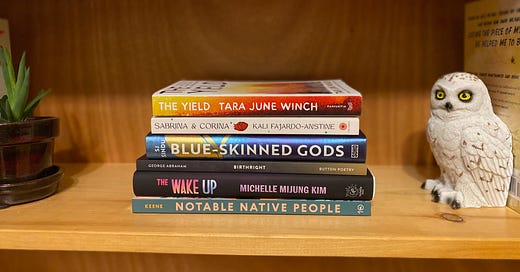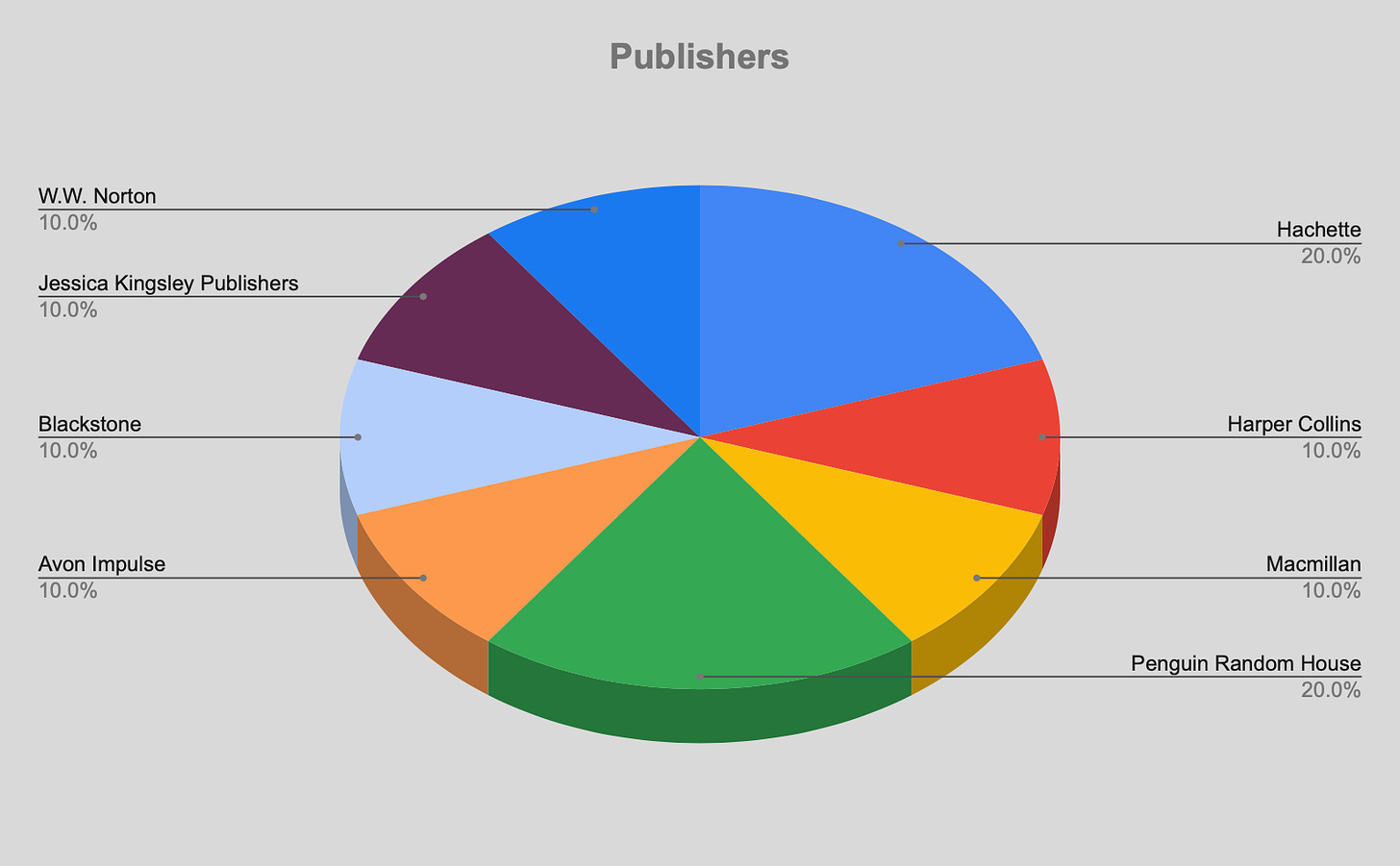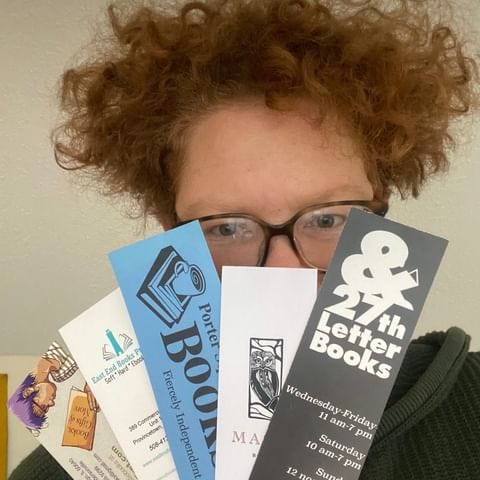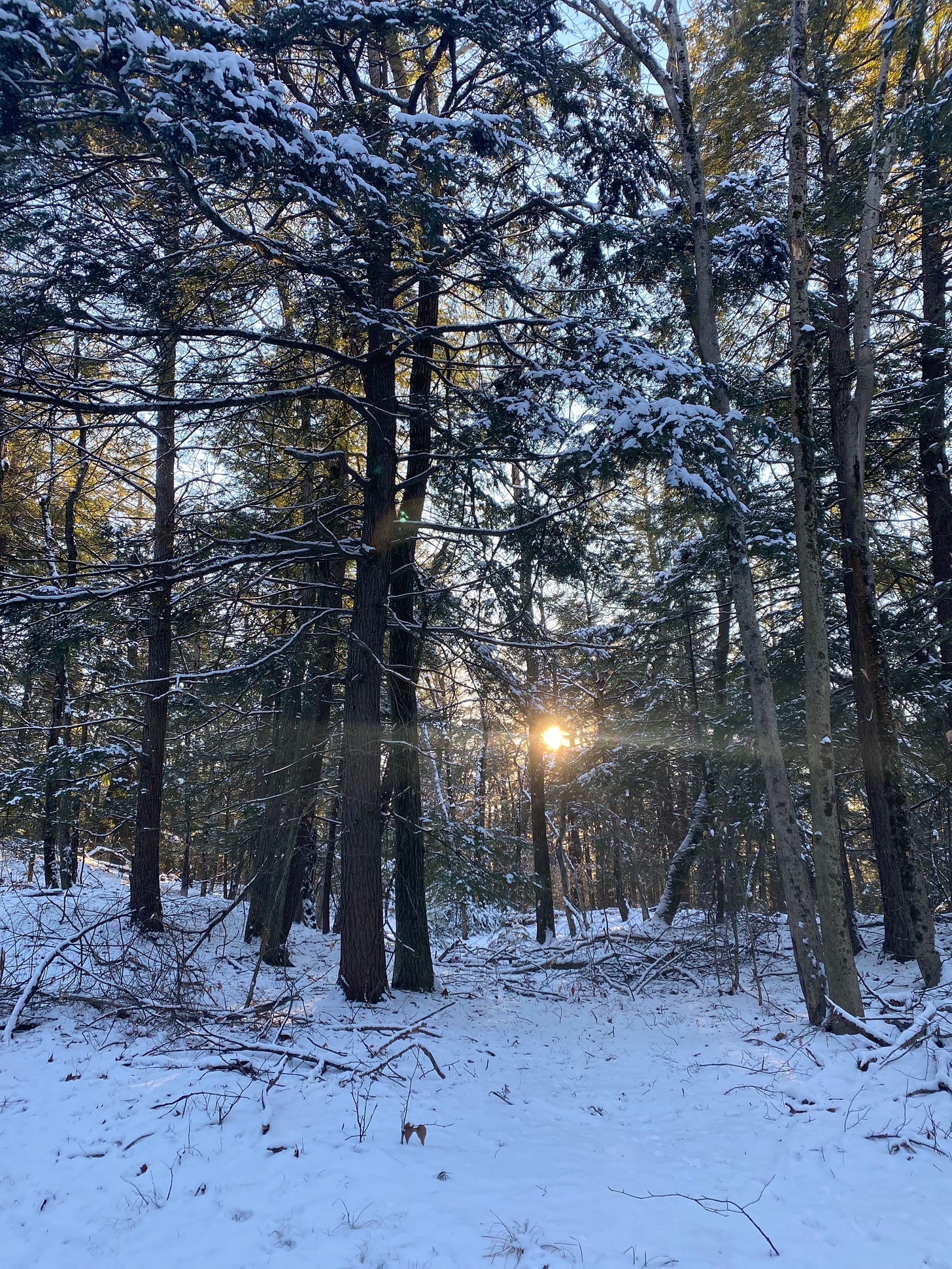Greetings, book and treat people! It feels like it’s been ages since my last newsletter. I had a lovely week of doing absolutely nothing, during which I read some books and ate a lot of cookies. Mostly, though, I sat on my couch and enjoyed the winter light in my living room and the birds at my feeder (lots of white-breasted nuthatches, red-bellied woodpeckers, and dark-eyed juncos). Last week I turned 36 and reveled in the most spectacular of spectacular winter walks:
Now I’m (slowly) settling into work again, and writing this newsletter is best part. Quite a few of you are new subscribers: welcome! I’m so thrilled you're here. I have so many amazing books and bakes to share with you this year. But first: data!
I’ve been keeping a reading spreadsheet since 2016, and a list of every book I’ve read for a lot longer than that. I don’t do this because I think it makes me a better reader. Yes, I have found that tracking my reading over the years has enriched my reading life, but I wouldn’t bother if I didn’t also love the literal act of entering the data into the spreadsheet. It gives me a thrill. It’s almost (but not quite) as fun as actually reading books.
One of my favorite end-of-year rituals is the time I spend with my reading spreadsheet, my journal, and a pot of tea, reflecting on the past year’s reading and making exciting plans for the coming year. For my first newsletter of 2022, I thought I’d share the highlights of that ritual with you.
For those of you interested in tracking your reading, I recommend Book Riot’s reading log. Mine is an edited version of that one.
Why Track?
One of the most interesting things about tracking my reading over the past seven years has been getting to see how much I’ve changed as a reader. Like a lot of readers I know, I started a reading spreadsheet with the goal of reading more books by authors from diverse backgrounds — race, gender, sexuality, nationality, etc. In 2016, 30% of the books I read were by BIPOC authors and 20% were by (known) queer authors. By 2021, both of those numbers had jumped to 50%. In 2016, I read one book by a trans author (I literally cannot believe this). In 2021, 18% of the books I read were by trans authors.
I mention this not to give myself a nice little pat on the back (ugh), but because it’s an example of how my reading spreadsheet functions as a tool that leads me to the books I want to be reading. My reading life is a million times better than it was ten years ago, and that’s because it’s filled with queer books and books that center BIPOC folks and nonfiction (I never used to read it!) and genres I hardly knew existed before (hello, romance!) and audiobooks and comics. I didn’t start reading all these kinds of books because I started tracking my reading — a lot of it has to do with being part of an incredible bookish community online. But tracking is part of it. Tracking gives me quantitative data to back up what I know intuitively about myself as a reader. It helps me figure out what works — so that I can do more of it.
Perhaps the most surprising thing I’ve learned about tracking is that the numbers are the least important thing about it. Sure, it means something that I read more books by BIPOC and LGBTQIA+ authors than I used to. But I’m not reading those books so that I can get to some arbitrary percentage. I’m reading them because they are brilliant and delightful and silly and challenging. I started reading more queer lit, it made me happier, I read even more queer lit, the percentage went up. It’s a positive feedback loop. I still track it, because I love data and can’t resist pretty charts. But it turns out that, for me, deciding to track something is the important piece. It’s a way of saying,"This matters to me. I am going to take the time to pay attention to this.” The rest follows by itself.
My reading spreadsheet is a living document. The fun part is revisiting it at the end of the year and asking lots of questions. What was good about my reading that year? What surprised me? What do I want more or less of in the coming year? And, crucially, what do I need to track to make that happen?
So here’s a peek into what I loved about 2021, and how I’m planning to translate that into an even better year of reading in 2022!
Reading Challenges
The biggest change I made to my 2021 reading spreadsheet was to set myself three specific challenges: read 75 books by trans authors, 50 books by Indigenous authors, and 50 books by disabled authors. I was already reading a lot of books by trans authors, hence the higher number.
I did not complete all of these challenges, but who cares! All three were unmitigated successes anyway. I like checklists, so that’s how I make goals. But 50 was just an arbitrary number. Finishing the challenge isn’t the point. The challenge is me setting an intention. For example: I read so many brilliant books by disabled writers in 2021 (like Pancopocalyse and Crip Kinship and There Plant Eyes and Weekend), and I acquired a lot more that I’ll be reading this year. Focusing on disability lit has expanded my world in a million ways. This is the miracle of a good tool: I made a special tab in my spreadsheet and embarked on a lifelong journey of learning and unlearning and growing and thinking.
I’ll be repeating these three challenges in 2022. I’m also adding two new ones:
Gems from the Shelves: Read 100 books I own. I’m super excited about this one because last year I got rid of a ton of books I have no interest in reading and bought a lot of books I badly want to read.
50 Countries: Read 50 books written by authors from 50 different countries, excluding the US, Canada, and the UK. I guarantee I won’t achieve this, but I’m so excited to see where it leads me.
Indie Presses
In 2021, 43% of the books I read were published by indie presses. I fell in love with so many presses: Arsenal Pulp, Metonymy, Milkweed, Coffee House, Seven Stories. I discovered how much fun it is to get to know a press. Now I treat publishers the same way I treat authors: when I finish a book I love, I check to see who published it, and if it’s a press I haven’t heard of, I immediately seek out more of their books. This is how I discovered Metonymy Press, and if you’ve been around here for a little while, you know how much I love them.
In the past I’ve paid some attention to publishers, but this year I’ll be tracking publishers much more carefully. I even made a pretty chart I can refer to, one that will (eventually!) show me how many books I read from each publisher.
Embracing Rereads
I reread 30 books last year! It was an absolute joy. Most of this rereading happened during Cookie Extravaganza in December, when I reread a ton of books on audio. Highlights included all 30+ hours of The Goldfinch, a re-listen of the first three Diviners novels, rereads of Circe and The Song of Achilles, and a slew of KJ Charles romances. But I also reread a few books that I read for the first time last year, including Butter Honey Pig Bread, Stone Fruit, and Several People Are Typing. I have never once regretted a reread and I am determined to make more space for rereading in 2022. A few books at the top of the reread list: The Prophets, In the Dream House, Freshwater, and all of Saga.
New Metrics
Every year I ditch some metrics and add others. Last year I tried tracking purchases, but it turned out to be useless. I already keep track of how much money I spend on books. There’s no point in tracking it in my reading spreadsheet, too. Here’s what I’m trying this year:
Audiobook Speed: At some point I started listening to books at 1.25x. Then I tried 1.5x. Now I occasionally listen at 1.75x. I switch it up depending on the book. Is there a correlation between how fast I listen to a book and how much I like it? And how much time do I actually spend listening to audiobooks? Inquiring minds want to know!
Reviews: Usually this newsletter contains three book reviews, not a bunch of data! I also post reviews on Instagram and Goodreads (and write for BookPage and Audiofile). But I don’t review every book I read, and I’m curious to know how many I do review. I’d like to review more than I do now, but I know reviewing every book I read is unrealistic. So I’m tracking it to see where I’m at.
Books & Community
Earlier this year I reflected a bit on how books brought me closer to other people, and to the world outside of myself, in 2021. I am a natural hermit. Reading has always been easy. People have always been a lot harder. In 2022, I want to focus on the ways that books connect me, not the way they isolate me (they can do both).
I’m still working on what that will look like. This newsletter is surely part of it!
More Book Browsing, Less Book Buying
I bought a lot of books in 2021. I never used to buy books regularly, but a few online orders from indie bookstores early in the pandemic soon turned into a full-fledged habit. I won’t be ordering nearly as many books this year. I also won’t ever again take for granted the sheer joy of browsing a bookstore in person. I started the year right with a birthday trip to Everyone’s Books in Brattleboro, and I plan to continue rooting myself in this place I call home by visiting a new bookstore each month. I live in the middle of the woods, but I can drive 35 minutes in any direction and hit a bookstore! I am incredibly lucky.
And One Arbitrary Goal…
I purposely keep my Goodreads to-read shelf at 100 books. This is an illusion, of course. In reality I have about 15 TBR lists made up of thousands of books: my physical bookshelves, favorites folders on four different audiobook apps, a spreadsheet of ARCs, my Libby holds list…but my Goodreads to-read shelf cannot exceed 100. I have a complicated system to keep it that way.
There are currently six books on that shelf that I added before 2021. I periodically go through and ditch books I’m no longer interested in, but I can’t seem to let go of these six. So I’ve given myself an ultimatum: if I haven’t read them by the end of this year, they’re gone. If you’re curious, the books are: What Lies Between Us by Nayomi Munaweera, Green Grass, Running Water by Thomas King, The Clay Girl by Heather Tucker, The Empathy Exams by Leslie Jamison, Diamond Head by Cecily Wong, and The Bone People by Keri Hulme. If you’ve read any of these and think I definitely should, too, I’d love to know!
Books & Bakes in the New Year
A huge thanks to everyone who filled out my reader survey last year! I loved hearing all of your thoughts and ideas. It’s a real joy to know that so many of you turn to this newsletter for queer book recs. That’ll continue to be my main objective in 2022: shout about all the queer books (and a few others). It’s what I love the most.
I also like spreadsheets and symmetry. You’ve probably noticed that this newsletter takes the same form each week (usually). That’s because structure thrills me. So, things will mostly look the same in 2022. I’ll still write about three books on a theme each week. But in the spirit of challenging myself to stay loose, I’m ditching all my hard and fast rules. I might not write about an upcoming book every week. I might not include every section each week. I might experiment with different formats, and put out different kinds of newsletters more often — reviews blended with personal writing, or more issues like the ones I wrote last year for Pride and The Sealey Challenge. We’ll see! I’m not making any promises.
I am doing one cool new thing, though:
A Book Spreadsheet for Paid Subscribers
A dear friend and subscriber suggested creating a spreadsheet of all the books I’ve recommended here, to make it easier to browse through them when looking for a new read. And because I can’t resist a spreadsheet (and it’s a great idea), I’m working on this. It’ll include all the books I’ve recommended, organized by genre, with links to my reviews. I’m hoping to have it ready next month, and then I’ll update it each week. This will only be available for paid subscribers. If you enjoy Books & Bakes and want to support my work, you can subscribe here.
As always, a little bit of beauty to send you on your way: I can’t help it. I am obsessed with winter.
And that’s it until next week. Catch you then!









Laura! These goals are so good. I especially love the publishers chart—I never thought about tracking that in my own log. Good luck!
What a delightful newsletter. I just subscribed. Substack really needs to up their game in the search functions. I usually search weekly for other "books and reading" newsletters and your newsletter was never on the list of results, darn. I just found you through our Google group that Elizabeth runs. I look forward to catching up on all your prior newsletters. :)